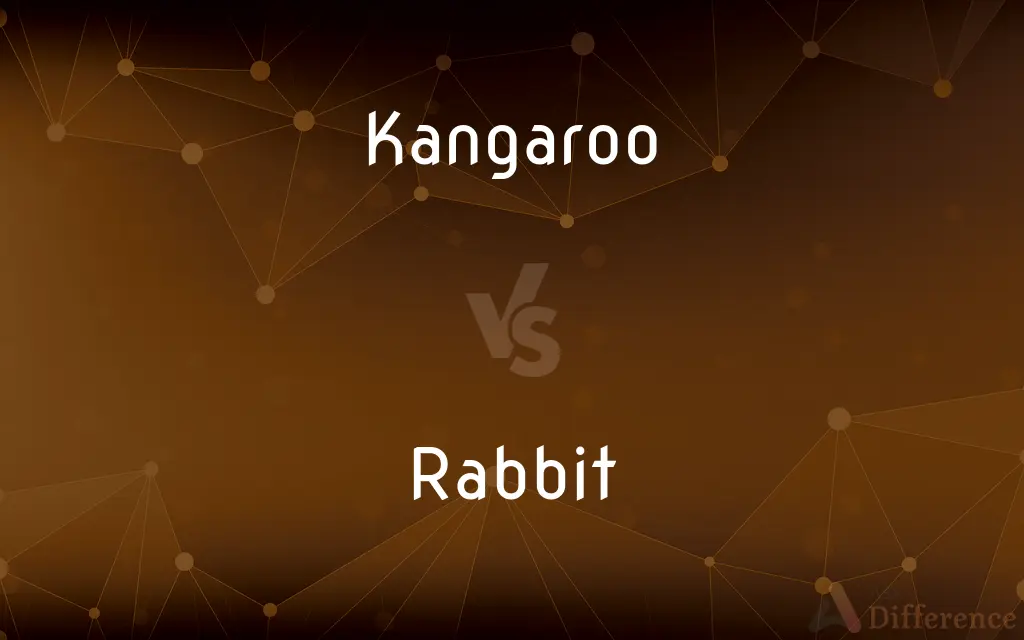Kangaroo vs. Rabbit — What's the Difference?
Edited by Tayyaba Rehman — By Fiza Rafique — Updated on October 11, 2023
Kangaroos are large marsupials native to Australia, known for hopping and carrying young in pouches. Rabbits are smaller mammals, widespread globally, known for burrowing and rapid reproduction.

Difference Between Kangaroo and Rabbit
Table of Contents
ADVERTISEMENT
Key Differences
Kangaroos are iconic animals native to Australia, recognized by their strong hind legs and long tails. These marsupials are distinctive for their mode of movement: hopping. On the contrary, rabbits are smaller mammals known for their long ears and whiskers, and they belong to the family Leporidae. Both kangaroos and rabbits are herbivores, but their habitats, physical characteristics, and behaviors set them apart.
A notable feature of the kangaroo is its pouch. Being marsupials, female kangaroos carry and nurse their undeveloped offspring in these pouches. Rabbits, however, give birth to more developed young, typically in burrows or nests. While both kangaroos and rabbits are known for their reproductive rates, the context differs. Kangaroos might have a more prolonged care period for their joeys, whereas rabbits can have multiple litters in a year.
In terms of habitat, kangaroos primarily reside in the diverse landscapes of Australia, from grasslands to deserts. They have adapted to various environments across the continent. Rabbits, however, are found on every continent except Antarctica. Introduced by humans to many regions, rabbits have become invasive in places like Australia, affecting local ecosystems. Both kangaroos and rabbits have had their run-ins with human populations, yet their interactions differ considerably.
Size-wise, kangaroos are much larger than rabbits. Some kangaroo species can stand taller than a human when fully upright. Rabbits, even the larger breeds, are much smaller in comparison. Despite these differences, both kangaroos and rabbits have become emblematic in their ways. Kangaroos symbolize Australia, appearing on national emblems, while rabbits have cultural significance globally, from folklore to festivals.
Comparison Chart
Origin
Native to Australia.
Found globally, except Antarctica.
ADVERTISEMENT
Reproduction
Marsupials with pouches for carrying young.
Give birth to more developed young in burrows or nests.
Size
Larger, some species can stand taller than humans.
Smaller, even the larger breeds are smaller than kangaroos.
Diet
Primarily herbivorous, grazing on grass and shrubs.
Herbivorous, eat a variety of plants including grass.
Symbolism
Represent Australia, appear on national emblems.
Have global cultural significance, from folklore to festivals.
Compare with Definitions
Kangaroo
Kangaroo is a marsupial native to Australia known for hopping movement.
The kangaroo is one of Australia's most iconic animals.
Rabbit
Rabbit is a small mammal known for its long ears and burrowing habits.
The garden was frequented by a wild rabbit.
Kangaroo
Kangaroo females have a pouch for nurturing their undeveloped offspring.
The baby kangaroo, or joey, peeked out from its mother's pouch.
Rabbit
Rabbit is recognized for its rapid reproduction rate.
Rabbits can have multiple litters in a year, leading to quick population growth.
Kangaroo
Kangaroo possesses powerful hind legs and a strong tail for balance.
The kangaroo used its strong tail to maintain balance while hopping.
Rabbit
Rabbit is a herbivore, consuming a diet of plants.
The rabbit nibbled on the fresh greens from the garden.
Kangaroo
Kangaroo species vary in size, from small wallabies to the large red kangaroo.
The red kangaroo is the largest marsupial in the world.
Rabbit
Any of various long-eared, short-tailed, burrowing mammals of the family Leporidae, such as the commonly domesticated species Oryctolagus cuniculus, native to Europe and widely introduced elsewhere, or the cottontail of the Americas.
Kangaroo
Kangaroo is often symbolically associated with Australia.
The kangaroo features prominently on the Australian coat of arms.
Rabbit
A hare.
Kangaroo
The kangaroo is a marsupial from the family Macropodidae (macropods, meaning "large foot"). In common use the term is used to describe the largest species from this family, the red kangaroo, as well as the antilopine kangaroo, eastern grey kangaroo, and western grey kangaroo.
Rabbit
The flesh of a rabbit, used as food.
Kangaroo
Any of various large herbivorous marsupials of the family Macropodidae of Australia and adjacent islands, having short forelimbs, large hind limbs used for leaping, and a long tapered tail.
Rabbit
The fur of a rabbit or hare.
Kangaroo
A member of the Macropodidae family of large marsupials with strong hind legs for hopping, native to Australia.
Rabbit
A competitor who is designated to set a fast pace for a teammate during a long-distance race.
Kangaroo
A hooded jacket with a front pocket, usually of fleece material, a kangaroo jacket.
Rabbit
A racehorse that is run at a fast pace early in a race in order to tire the favorite so that another horse can take the lead.
Kangaroo
To practice kangaroo care on an infant; to hold a premature infant against the skin.
Rabbit
A mechanical decoy that is propelled around the track in a greyhound race to incite the dogs.
Kangaroo
(intransitive) To hunt kangaroo.
Rabbit
To hunt rabbits or hares.
Kangaroo
(intransitive) To move like a kangaroo.
Rabbit
A mammal of the family Leporidae, with long ears, long hind legs and a short, fluffy tail.
The pioneers survived by eating the small game they could get: rabbits, squirrels and occasionally a raccoon.
Kangaroo
Of or relating to Australia.
Rabbit
(uncountable) The meat from this animal.
Kangaroo
Characterized by rapidly jumping prices in securities markets or by belief that the prices are unstable in contrast to bear and bull markets.
Rabbit
(uncountable) The fur of a rabbit typically used to imitate another animal's fur.
Kangaroo
Any one of numerous species of jumping marsupials of the family Macropodidæ. They inhabit Australia, New Guinea, and adjacent islands, They have long and strong hind legs and a large tail, while the fore legs are comparatively short and feeble. The giant kangaroo (Macropus major) is the largest species, sometimes becoming twelve or fourteen feet in total length. The tree kangaroos, belonging to the genus Dendrolagus, live in trees; the rock kangaroos, of the genus Petrogale, inhabit rocky situations; and the brush kangaroos, of the genus Halmaturus, inhabit wooded districts. See Wallaby.
Rabbit
A runner in a distance race whose goal is mainly to set the pace, either to tire a specific rival so that a teammate can win or to help another break a record; a pacesetter.
Kangaroo
Any of several herbivorous leaping marsupials of Australia and New Guinea having large powerful hind legs and a long thick tail
Rabbit
(cricket) A very poor batsman; selected as a bowler or wicket-keeper.
Rabbit
(comptheory) A large element at the beginning of a list of items to be bubble sorted, and thus tending to be quickly swapped into its correct position. Compare turtle.
Rabbit
Rarebit; Welsh rabbit or a similar dish: melted cheese served atop toast.
Rabbit
A pneumatically-controlled tool used to insert small samples of material inside the core of a nuclear reactor.
Rabbit
(intransitive) To hunt rabbits.
Rabbit
To flee.
The informant seemed skittish, as if he was about to rabbit.
When the three friends heard someone behind them yell, "police, freeze!" they each rabbited in a different direction.
Rabbit
To talk incessantly and in a childish manner; to babble annoyingly.
Rabbit on
Stop your infernal rabbiting! Use proper words or nobody will listen to you!
Rabbit
Confound; damn; drat.
Rabbit
Any of the smaller species of the genus Lepus, especially the common European species (Lepus cuniculus), which is often kept as a pet, and has been introduced into many countries. It is remarkably prolific, and has become a pest in some parts of Australia and New Zealand.
Rabbit
Any of various burrowing animals of the family Leporidae having long ears and short tails; some domesticated and raised for pets or food
Rabbit
The fur of a rabbit
Rabbit
Flesh of any of various rabbits or hares (wild or domesticated) eaten as food
Rabbit
Hunt rabbits
Rabbit
Rabbit has cultural significance in many societies, often associated with luck.
The rabbit's foot is sometimes considered a good luck charm.
Rabbit
Rabbit species and breeds vary in size, color, and coat patterns.
The Angora rabbit is known for its long, soft fur.
Common Curiosities
What is a kangaroo?
A kangaroo is a marsupial native to Australia, known for its hopping movement and pouch for carrying young.
What is a rabbit?
A rabbit is a small mammal with long ears, known for burrowing and its rapid reproduction rate.
Share Your Discovery

Previous Comparison
Engage vs. Interest
Next Comparison
Prisoner vs. InmateAuthor Spotlight
Written by
Fiza RafiqueFiza Rafique is a skilled content writer at AskDifference.com, where she meticulously refines and enhances written pieces. Drawing from her vast editorial expertise, Fiza ensures clarity, accuracy, and precision in every article. Passionate about language, she continually seeks to elevate the quality of content for readers worldwide.
Edited by
Tayyaba RehmanTayyaba Rehman is a distinguished writer, currently serving as a primary contributor to askdifference.com. As a researcher in semantics and etymology, Tayyaba's passion for the complexity of languages and their distinctions has found a perfect home on the platform. Tayyaba delves into the intricacies of language, distinguishing between commonly confused words and phrases, thereby providing clarity for readers worldwide.














































